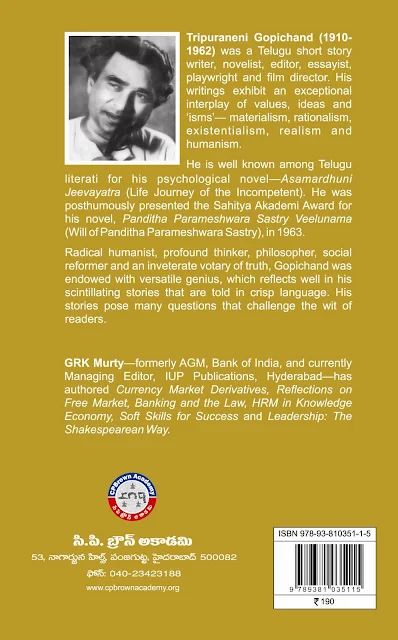Tripuraneni Gopichand

Contents
1. Attachment (Mamakaram) [Page No. 13]
2. Introspection (Atmagatam) [Page No. 21]
3. Rivalry (Spardha) [Page No. 31]
4. Obedient Husband (Bharyaloludu) [Page No. 35]
5. Fear (Bhayam) [Page No. 36]
6. Bus Halted - Left (Bus Aaagindi – Poindi) [Page No. 38]
7. Impoverishment (Daridrayam) [Page No. 43]
8. All in Wives (Bharyallone Undi) [Page No. 48]
9. Ego (Aham) [Page No. 57]
10. Neighborhood (Irugu Porugu) [Page No. 58]
11. The Most Harassed Heart (Peeditha Hridayam) [Page No. 65]
12. Human Life (Manava Jeevitham) [Page No. 71]
13. Self-Done (Swayamkrutam) [Page No. 72]
14. The Retired Ox (Arru Kadigina Eddu) [Page No. 78]
15. Mother (Amma) [Page No. 84]
16. It Could Happen Like This (Ila Jarigenu) [Page No. 87]
17. Me – My Character (Nenu Na Patra) [Page No. 92]
18. Babul Tree (Thumma Chettu) [Page No. 93]
19. The Lamp of Hope (Asajyoti) [Page No. 98]
20. Hindu Chastity (Hindu Pativratyam) [Page No.108]
21. Suicide (Atmahatya) [Page No. 112]
22. Sinful Society (Papisti Sangham) [Page No. 117]
23. Maidservant (Pani Pilla) [Page No. 118]
24. Elders’ Sayings (Peddala Suddulu) [Page No. 122]
25. Money! Money! Money! (Dabbu! Dabbu! Dabbu!) [Page No.123]
26. Fallen Women (Patitalu) [Page No. 127]
27. Ancestral Property (Pitrarjitam) [Page No. 139]
28. Sympathy (Sanubhuti) [Page No. 144]
29. Fathers, Sons (Thandrulu, Kodukulu) [Page No. 145]
30. Wife and Husband (Bharya Bhartalu) [Page No. 165]
Introduction
Tripuraneni Gopichand (1910-62) was a very significant creative writer in Telugu. The popularity and influence of his writings is quite far and wide among the Telugu speaking people.
Though a prolific writer, Gopichand was not carried away by the ruling fashion of story telling, nor did he mechanically repeat himself. On the other hand, his story telling took wings, traversing from villages—farmers, agricultural laborers—to urban middle-class; from communism, rationalism, realism, to naturalism. Most of his stories show with an unsparing realism how the finite man is quite often pitted against heavy nerve-racking odds. His stories are a quest for truth, not power: there is no violence. They present a wide tapestry of human action.
He never entertained the fancy of verbal pyrotechniques. His stories are all about the complexities of ordinary people’s lives narrated with clinical precision, that too, in ordinary language. Some of them depict the agony, anguish, and conflict of the modern and educated middle-class women caught between patriarchy and tradition on the one hand, and individuality, self-expression and independence on the other. Suffice it to say, his short stories run quite “tight and nervy as the top string of a violin.”
Gopichand’s stories invoke ‘multitudes’— each new reading generates a fresh understanding about humanism and rationalism and yet there remains some certain creative element unexhausted. He writes pithy dialogues leaving much unsaid for the reader to visualize. Yet, they make a powerful impact on the reader.
Reading his stories is sure to lead to enlargement of the boundaries of understanding human behavior, man’s expectations, limitations thereof, conflicts (both inter and intra), coping or not coping with life’s scaffold, idealism, bravery, temerity, reticence, and whatnot—in short, every nuance of human life and its endeavors.
A reader of his stories, indeed, experiences a sense of discovering himself. The inexhaustible insights they offer, the fragrance of their originality, their world view invariably leave an indelible mark on the reader. They do not, of course, provide ready-made answers to the problems that man faces today. But certainly they contribute to a profound understanding of the age in which we live.
His stories—told stirringly well—make us aware of our private fears, apprehensions, insecurities, joys and hopes. The ideas behind the story enable a reader to visualize the paradigms of essential human nature and discover the relevance of an idea and the precise significance of every human emotion to better appreciate the human predicament. They simply propel us out of our passivity and inertia into action— action, of course, solely guided by reason.
This book is a collection of selected short stories of Gopichand. By and large all the stories articulate the inherent heterogeneity of existence, and are obsessed with reality. It is hoped that the selection offers a fair representation of his extensive canvas. After all, an anthology is always a reflection of the editor’s choice and always vulnerable to accusations of lack of ‘representativity’. True, another editor might have chosen differently. But the stories included in this collection have to be looked at positively, for they have been chosen with an eye on the underlying statement of each story rather than their readability. In my view, they offer a balanced and objective representation of Gopichand’s literary genius.
For more information about the book, log on to: www.cpbrownacademy.org

No comments:
Post a Comment